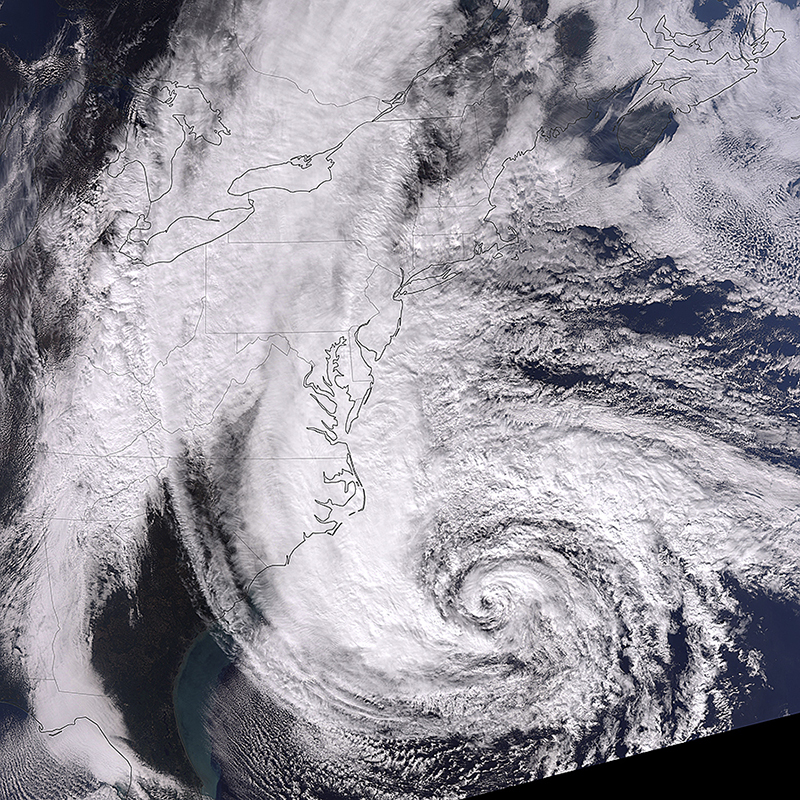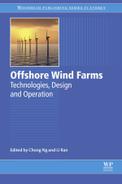Ainslie J.F. Calculating the flowfield in the wake of wind turbines. Journal of Wind Engineering and Industrial Aerodynamics. 1988;27:213–224.
American Bureau of Shipping (ABS). Guide for Building and Classing Bottom-Founded Offshore Wind Turbine Installations. 2013.
American Bureau of Shipping (ABS). Guide for Building and Classing Floating Offshore Wind Turbine Installations. 2013.
American Petroleum Institute (API). Interim Guidance on Hurricane Conditions in the Gulf of Mexico. 2007 API 2INT-MET.
Ayotte K, Taylor P. A mixed spectral finite-difference 3D model of neutral planetary boundary-layer flow over topography. Journal of the Atmospheric Sciences. 1995;52:3523–3537.
Bailey B, Wilson W. The value proposition of load coincidence and offshore wind. North American Windpower. 2014;10:10–11.
Barthelmie R.J, Pryor S.C, Frandsen S.T, Hansen K.S, Schepers J.G, Rados K, Schlez W, Neubert A, Neubert L.E, Jensen L.E, Neckelmann S. Quantifying the impact of wind turbine wakes on power output at offshore wind farms. Journal of Atmospheric and Oceanic Technology. 2010;27:1302–1317.
Barthelmie R.J, Folkerts L, Ormel F, Sanderhoff P, Eecen P, Stobbe O, Nielsen N. Offshore wind turbine wakes measured by sodar. Journal of Atmospheric and Oceanic Technology. 2003;20:466–477.
Beaucage P, Brower M, Robinson N, Alonge C. Overview of six commercial and research wake models for large offshore wind farms. In: Proceedings from the EWEA Conference, 16–19 April 2012, Copenhagen, Denmark. 2012.
Beaucage P, Glazer A, Choisnard J, Yu W, Bernier M, Benoit R, Lafrance G. Wind assessment in a coastal environment using the synthetic aperture radar satellite imagery and a numerical weather prediction model. Canadian Journal of Remote Sensing. 2007;33:368–377.
Beljaars A, Walmsley J, Taylor P. A mixed spectral finite-difference model for neutrally stratified boundary-layer flow over roughness changes and topography. Boundary-Layer Meteorology. 1987;38:273–303.
Berge E, Hahmann A, Bredesen R, Hasager C, Byrkjedal O, Costa P, Stoffelen A. On the utilization of meso-scale models for offshore wind atlases. In: EWEA Offshore 2011, Amsterdam, The Netherlands. 2011.
Berge E, Byrkjedal O, Ydersbond Y, Kindler D. Modelling of offshore wind resources: comparison of a mesoscale model and measurements from FINO 1 and North sea oil rigs. In: Proc. EWEA Conference. 2009.
Brower M.C, ed. Wind Resource Assessment: A Practical Guide to Developing a Wind Project. New York: John Wiley & Sons; 2012 280 pp.
Brower M.C, Barton M.S, Lledo L, Dubois J. A Study of Wind Speed Variability Using Global Reanalysis Data. Technical Report from AWS Truepower; 2013. 11 pp. Available at: https://www.awstruepower.com/knowledge-center/technical-papers/.
Brower M. Validation of the WindMap program and development of MesoMap. In: Proceeding from AWEA's 1999 WindPower Conference. Washington, DC, USA. 1999.
Brower M, Robinson N. The OpenWind Deep-Array Wake Model: Development and Validation. Albany, NY, USA: Technical report from AWS Truepower; 2009 15 p. http://www.awsopenwind.org/downloads/documentation/DAWM_WhitePaper.pdf.
Calaf M, Meneveau C, Meyers J. Large eddy simulation study of fully developed wind-turbine array boundary layers. Physics of Fluids. 2010;22:015110. doi: 10.1063/1.3291077.
Churchfield M.J, Lee S, Moriarty P.J, Martinez L.A, Leonardi S, Vijayakumar G, Brasseur J.G. A large-eddy simulation of wind plant aerodynamics. In: Proceedings from the American Institute of Aeronautics and Astronautics, Nashville, TN, USA. 2012 19 pp.
Colle B.A, Novak D.R. The New York Bight jet: climatology and dynamical evolution. Monthly Weather Review. 2010;138:2385–2404.
Cox S. Validation of the FLiDAR Floating LiDAR Offshore Wind Measurements Device. 2014 DNV-GL Report 14.09.01, Bristol, England.
Decker M, Brunke M.A, Wang Z, Sakaguchi K, Zeng X, Bosilovich M.G. Evaluation of the reanalysis products from GSFC, NCEP, and ECMWF using flux tower observations. Journal of Climate. 2012;25:1916–1944.
Det Norske Veritas (DNV). Design of Offshore Wind Turbine Structures. 2013 DNV-OS-J101.
Dvorak M, Corcoran B, Ten Hoeve J, McIntyre N, Jacobson M. US East Coast offshore wind energy resources and their relationship to peak-time electricity demand. Wind Energy. 2013;16:977–997.
Dvorak M, Pimenta F, Veron D, Colle B. Electric power from offshore wind via synoptic-scale interconnection. Proceedings of the National Academy of Sciences of the United States of America. 2010;107.
Elliott D, Schwartz M, Haymes S, Helmiller D, Scott G, Flowers L, Brower M, Hale E, Phelps B. 80 and 100 meter wind energy resource potential for the United States. In: AWEA Poster, Windpower Conference, Dallas, TX, May 23–26, 2010. 2010. www.eere.energy.gov/wind/windexchange/pdfs/wind_maps/poster_2010.pdf.
Frank H, Rathman O, Mortensen N, Landberg L. The Numerical Wind Atlas – the KAMM/WAsP Method. Roskilde, Denmark: Report from the Risoe DTU National Laboratory; 2001 59 pp.
Freedman J, Bailey B, Young S, Zack J, Manobianco J, Alonge C, Brower M. Offshore wind power production and the sea breeze circulation. In: Proc. AMS Conf., Atlanta, GA. 2010.
Gilliam R, Bhave P, Pleim J, Otte T. A year-long MM5 evaluation using a model evaluation toolkit. In: Presented at 2004 Models-3 Conference, Chapel Hill, NC, Oct. 18–20, 2004. 2004.
Hasager C, Karagali I, Badger M, Mouche A, Stoffelen A. Offshore wind atlas for Northern European seas. In: ESA Living Planet Symposium, Bergen 2010. 2010.
Hung J, Hsu W, Chang P, Yang R, Lin T. The performance validation and operation of nearshore wind measurements using the floating lidar. Coastal Engineering. 2014;2014:1–9.
International Electrotechnical Commission (IEC). IEC 61400-3, Wind Turbines – Part 1: Design Requirements. third ed. 2005.
International Electrotechnical Commission (IEC). IEC 61400-12-1, Wind Turbines – Part 12-1: Power Performance Measurements of Electricity Producing Wind Turbines. first ed. 2005.
International Electrotechnical Commission (IEC). IEC 61400-3, Wind Turbines – Part 3: Design Requirements for Offshore Wind Turbines. 2009.
International Organization for Standardization (ISO). Standard Atmosphere. ISO 2533:1975 (E). 1975.
Jackson P, Hunt J. Turbulent wind flow over low hill. Quarterly Journal of the Royal Meteorological Society. 1975;101:929–955.
Jensen N.O. A Note on Wind Generator Interaction. Roskilde, Denmark: Technical Report from the Risø National Laboratory (Risø-M-2411); 1983 16 p.
Jimenez A, Crespo A, Migoya E, Garcia J. Advances in large-eddy simulation of a wind turbine wake. Journal of Physics: Conference Series. 2007;75.
Johnson C, Graves A, Tindal A, Cox S, Schlez W, Neubert A. New developments in wake models for large wind farms. In: Poster Presentation at the 2009 AWEA Windpower Conf., Chicago. 2009. Available from: www.dnvgl.com/search.
Kalnay E, Kanamitsu M, Kistler R, Collins W, Deaven D, Gandin L, Iredell M, Saha S, White G, Woollen J, Zhu Y, Leetmaa A, Reynolds R, Chelliah M, Ebisuzaki W, Higgins W, Janowiak J, Mo K, Ropelewski C, Wang J, Jenne R, Joseph D. The NCEP-NCAR 40-year reanalysis project. Bulletin of the American Meteorological Society. 1996;77:437–471.
Katic I, Hojstrup J, Jensen N.O. A simple model for cluster efficiency. In: Proceedings from the European Wind Energy Conference, Rome, Italy. 1986 5 p.
Kistler R, Kalnay E, Collins W, Saha S, White G, Woollen J, Chelliah M, Ebisuzaki W, Kanamitsu M, Kousky V, van den Dool H, Jenne R, Fiorino M. The NCEP/NCAR reanalysis. Bulletin of the American Meteorological Society. 2001;8:247–267.
Larsen T.J, Madsen H.A, Larsen G.C, Hansen K.S. Validation of the dynamic wake meander model for loads and power production in the Egmond aan Zee wind farm. Wind Energy. 2012;16:605–624.
Lee C, Chen S.S. Symmetric and asymmetric structures of hurricane boundary layer in coupled atmosphere-wave-ocean models and observations. Journal of Atmospheric Sciences. 2012;69:3576–3594.
Lileo S, Petrik O. Investigation on the use of NCEP/NCAR, MERRA and NCEP/CFSR reanalysis data in wind resource analysis. In: Presentation Given at the EWEA Conference, Brussels, Belgium. 2011.
Mirocha J.D, Kosovic B, Aitken M.L, Lundquist J.K. Implementation of a generalized actuator disk wind turbine model into the weather research and forecasting model for large-eddy simulation applications. Journal of Renewable and Sustainable Energy. 2014;6:013104. doi: 10.1063/1.4861061.
Montavon C, Hui S.-Y, Graham J, Malins D, Housley P, Dahl E, de Villiers P, Gribben B. Offshore wind accelerator: wake modelling using CFD. In: Proceedings from the EWEA Offshore Conference, 29 Nov.–1 Dec. 2011. 2011.
Ott S, Berg J, Nielsen M. Linearised CFD Models for Wakes. Roskilde, Denmark: Technical Report from the Risø National Laboratory (Risø-R-1772); 2011 41 pp.
Peng Z. Wave slamming impact on offshore wind turbine foundations. Coastal Engineering. 2014;1(34).
Schlez W, Neubert A. New developments in large wind farm modeling. In: Proceedings from the EWEA Conference 2009, Marseille, France. 2009 8 pp.
Schwartz M, Heimiller D, Haymes S, Musial W. Assessment of Offshore Wind Energy Resources for the United States Technical Report NREL/TP-500–45880. Golden, CO: National Renewable Energy Lab; 2010.
Scire J, Robe F, Fernau M, Yamartino R. A User's Guide for the CALMET Meteorological Model (Version 5). Concord, Massachusetts, USA: Report from Earth Tech, Inc.; 2000 p. 332.
Steele C, Dorling S, von Glasow R, Bacon J. Idealized WRF model sensitivity simulations of sea breeze types and their effects on offshore windfields. Atmospheric Chemistry and Physics. 2013;13:443–461.
Steele C, Dorling S, von Glasow R, Bacon J. Modelling sea-breeze climatologies and interactions on coasts in the southern North Sea: implications for offshore wind energy. Quarterly Journal of the Royal Meteorological Society. 2014;141(690):1821–1835.
Stoelinga M, Hendrickson M, Storck P. Downscaling global reanalyses with WRF for wind energy resource assessment. In: Presentation at the WRF Users Workshop. 2012 25 slides.
Stout M. Protecting wind turbines in extreme temperatures. Renewable Energy World. June 26, 2013.
Stull R.B. An Introduction to Boundary Layer Meteorology. Dordrecht, The Netherlands: Kluwer; 1988.
Sutton O.G. Micrometeorology. New York: McGraw-Hill Book Company; 1953 333 p.
Taylor P, Walmsley J, Salmon J. A simple model of neutrally stratified boundary-layer flow over real terrain incorporating wave number-dependent scaling. Boundary-Layer Meteorology. 1983;26:169–189.
Troen I, Petersen E. European Wind Atlas. Roskilde, Denmark: Report from the Risø National Laboratory; 1989.
Troen I. A high resolution spectral model for flow in complex terrain. In: Proc. 9th Symposium on Turbulence and Diffusion. 1990 Roskilde, Denmark.
Troldborg N, Sørensen J, Mikkelsen R, Sørensen N. A simple atmospheric boundary layer model applied to large eddy simulations of wind turbine wakes. Wind Energy. 2014;17:657–669. doi: 10.1002/we.1608.
Wu Y.-T, Porté-Agel F. Large-eddy simulation of wind-turbine wakes: evaluation of turbine parameterizations. Boundary-Layer Meteorology. 2011;138:345–366.
Yu W, Benoit R, Girard C, Glazer A, Lemarquis D, Salmon J, Pinard J. Wind energy simulation toolkit: a wind mapping system for use by wind energy industry. Wind Engineering. 2006;30:15–33.
Zang J, Taylor P, Tello M. Steep wave and breaking wave impact on offshore wind turbine foundations—ringing re-visited. In: Proc. Int. Workshop on Water Waves and Floating Bodies. 2015 United Kingdom.















